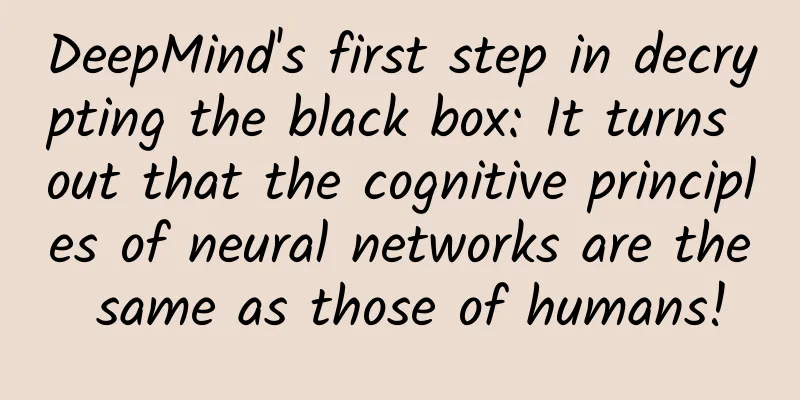What are machine learning and deep learning? Faizan Shaikh will help you answer

|
Abstract: This article introduces the definitions and applications of machine learning and deep learning in easy-to-understand language, as well as the differences in source data requirements, hardware support, feature engineering, problem solving methods, execution time and interpretability, which is of great enlightenment significance for novices. wedge: Machine learning and deep learning are very popular now, and you will find that suddenly many people are talking about them. As shown in the following figure, the trend comparison of machine learning and deep learning (from Google trend, the vertical axis represents the search popularity): This article will explain the difference between deep learning and machine learning in detail with simple and easy-to-understand language and examples, and introduce their related uses. Introduction to Machine Learning and Deep Learning Machine Learning Tom Mitchell’s widely cited definition of machine learning is as follows: For some class of tasks T and performance metric P, a computer program is said to learn from experience E if its performance on T, as measured by P, improves with experience E. “A computer program is said to learn from experience E with respect to some class of tasks T and performance measure P if its performance at tasks in T, as measured by P, improves with experience E ” The above abstract definition may confuse you, but I believe the following simple examples will make it clear. [Example 1 Predicting weight based on height] Suppose you want to create a system that predicts a person's weight based on their height. The first step is to collect data. After collecting data, draw a data distribution graph as shown below. Each point in the graph represents a piece of data, the horizontal axis represents height, and the vertical axis represents weight. We can draw a simple straight line to predict weight from height, for example: Weight (in kg) = Height (in cm) - 100 If this line predicts height very accurately, how do we measure its performance? For example, we can measure the performance of the prediction model by the difference between the predicted value and the true value. Of course, the more source data, the better the model will be. If the performance is not good, then other methods can be used to improve the model performance, such as adding variables (such as gender) or changing the prediction line. 【Example 2 Storm Prediction System】 Suppose you want to build a storm prediction system, and you have data on past storms and weather data from three months before these storms. So how do you build a storm prediction system? The first thing to do is to clean the data and find hidden patterns in the data, such as the conditions that lead to storms. We can model some conditions, such as whether the temperature is greater than 40 degrees Celsius and whether the humidity is between 80 and 100, and then feed these features into the model. What you need to do is to make full use of historical data and then predict whether a storm will occur. In this example, the evaluation metric is the number of storms correctly predicted. We can repeat the prediction process many times and then return the performance results to the system. Going back to the original definition of machine learning, we define the storm prediction system as follows: the task T is to find the atmospheric conditions that cause storms, the performance P is the number of correct predictions after the model parameters are learned, and the experience E is the iterative process of the system. Deep Learning Deep learning actually appeared a long time ago, and with the hype in recent years, it has gradually become popular again. Deep learning is a special type of machine learning that represents the real world as a nested hierarchical system of concepts (complex concepts are defined by the connections between simpler concepts, from general abstractions to high-level abstract representations), thereby achieving powerful performance and flexibility. Deep learning is a particular kind of machine learning that achieves great power and flexibility by learning to represent the world as nested hierarchy of concepts, with each concept defined in relation to simpler concepts, and more abstract representations computed in terms of less abstract ones. 【Example 1 Graphics Detection】 Suppose we want to distinguish rectangles from other shapes. The human eye first detects whether the shape has 4 sides (simple concept). If there are 4 sides, then detect whether they are connected, closed, vertical, and equal (nested hierarchical concept). In fact, we have decomposed a complex task (rectangle recognition) into some simple low-level abstraction tasks. Deep learning essentially does this on a larger scale. [Example 2 Cat or dog] This case study is about building a system that can recognize whether the animal in a picture is a cat or a dog. If we use machine learning to solve this problem, we first need to define some features, such as whether the animal has whiskers and ears; if it has ears, whether the ears are pointed. In simple terms, we need to define facial features and then let the system identify which features are important in animal classification. Deep learning can complete these tasks at once. Deep learning will automatically find the features that are important for the classification task, while machine learning has to be manually specified. The deep learning workflow is as follows: 1. First, find the boundary in the image that is most relevant to cats or dogs; 2. Then find the combination of shapes and boundaries, such as whether you can find whiskers and ears; 3. After the continuous layered recognition of complex concepts, it is possible to determine which features are important in identifying cats and dogs. Comparison between machine learning and deep learning Data Dependency The most important difference between deep learning and traditional machine learning is that its performance improves as the amount of data increases. If there is little data, deep learning algorithms do not perform well because they need a lot of data to understand the patterns contained in it. In this case, traditional machine learning with manually specified rules prevails. This is shown in the figure below: Hardware Support Deep learning algorithms rely heavily on high-end machines, while traditional machine learning can run on low-end machines. Because deep learning requires a large number of matrix multiplication operations, and GPUs can effectively optimize these operations, GPUs have become an indispensable part of it. Feature Engineering Feature engineering feeds domain knowledge into feature extractors, reducing data complexity and making patterns in the data more obvious to learning algorithms, leading to better results. This process is expensive in terms of time and expertise. In machine learning, most features used are specified by experts or determined based on prior knowledge for each data domain and data type. For example, features can be pixel values, shapes, textures, positions, and orientations. The performance of most machine learning methods depends on the accuracy of identifying and extracting these features. Deep learning algorithms try to learn high-level features from data, which is part of what makes deep learning different and an important step beyond traditional machine learning. Deep learning reduces each problem to developing a new feature extractor, such as a convolutional neural network that learns low-level features such as edges and lines at the bottom, then features of facial parts, and finally high-level features of faces. Problem Solution When using traditional machine learning methods to solve problems, the strategy is often to break the whole into parts, solve them separately, and then combine the results to solve them. Deep learning advocates an end-to-end model, inputs training data, directly outputs the final result, and lets the network learn how to extract key features. For example, if you want to perform target detection, you need to identify the category of the target and point out its location in the image. The typical machine learning method divides this problem into two steps: object detection and object recognition. First, use bounding box detection technology, such as grabcut, to scan the entire image to find all possible objects, and use object recognition algorithms, such as HOG/SVM, to identify related objects. Deep learning methods handle this problem in an end-to-end manner. For example, YOLO net can achieve target location and recognition through convolutional neural networks. That is, the original image is input into the convolutional neural network, and the location and category of the target in the image are directly output. Execution time Typically, deep learning takes a long time to train because many parameters in deep learning take much longer to train than normal. ResNet takes about two weeks to train from scratch, while machine learning only takes a few seconds to a few hours to train. The time required for testing is completely opposite, deep learning algorithms take very little time to run. However, compared to KNN (K nearest neighbors, a machine learning algorithm), the testing time will increase as the amount of test data increases. However, not all machine learning algorithms take a long time, and some only require very little testing time. Explainability If you use deep learning to automatically score articles, you will find that the performance will be very good and close to the human scoring level. But it cannot explain why such a score is given. During the operation, you can find which nodes of the deep neural network are activated, but you don’t know what these neurons are modeling and what each layer is doing, so you can’t explain the results. On the other hand, machine learning algorithms such as decision trees clearly explain the reasons for making choices at each step according to the rules. Therefore, algorithms such as decision trees and linear/logistic regression are widely used in industry due to their good interpretability. Machine learning and deep learning application scenarios Wiki introduces some application areas of machine learning: 1. Computer vision: such as license plate recognition and face recognition; 2. Information retrieval: such as search engines, text retrieval, image retrieval; 3. Marketing: automatic email marketing, target identification; 4. Medical diagnosis: cancer diagnosis, abnormality detection; 5. Natural language processing: semantic analysis, photo tagging; 6. Online advertising , etc. The figure below summarizes the application areas of machine learning. In general, the application range is very wide. Google is a well-known company in the industry that uses machine learning/deep learning. As shown in the figure below, Google applies deep learning to different products. Instant Test To assess whether you really understand the difference between machine learning and deep learning, here is a quick test that you can submit your answers to here. All you have to do is solve the following problems using both machine learning and deep learning and decide which approach is better. [Scenario 1] Suppose you want to develop an unmanned vehicle system that takes raw data captured by a camera as input and then predicts the direction and angle of the steering wheel. [Scenario 2] Given a person's credit credentials and background information, evaluate whether a loan can be granted to him. 【Scenario 3】Create a system to translate Russian text into Indian languages. Future Trends The previous section summarizes the differences between machine learning and deep learning. This section discusses the future trends of the two: 1. Given the increasing trend of using data science and machine learning in industry, using machine learning in business is becoming more and more important for companies that want to survive. At the same time, it is also necessary to understand more basic knowledge. 2. Deep learning is giving us more and more surprises, and it will continue to do so in the future. Deep learning has been proven to be one of the most advanced and best technologies in the existing technologies. 3. Research on deep learning and machine learning is still going on, and is not limited to academia as before. Currently, machine learning and deep learning are developing explosively in industry and academia. And they are supported by more funds than before, and are likely to become one of the key points in human development. end This article compares deep learning and machine learning in detail, hoping to inspire you to learn more. Please refer to the machine learning roadmap and deep learning roadmap. 【About the Author】
Faizan Shaikh, a data science enthusiast, is obsessed with deep learning and artificial intelligence. The above is the translation This article is recommended by teacher @爱可可-爱生活 from Beijing University of Posts and Telecommunications and translated by Alibaba Cloud Yunqi Community. The article is a simplified translation. For more detailed content, please check the original text The original English text can be downloaded as an attachment: Comparis...[【Direction】].1493902277.pdf |
>>: Android dynamic proxy and using dynamic proxy to implement ServiceHook
Recommend
Technology and market play a significant role in Chuangwei's leading position in the industry. Thoughts after 2014
January 5 (Reporter Zhang Xiaodong) The end of 20...
How to use TikTok to acquire 300,000 customers?
In this article, let’s take a look at how to use ...
Tieling SEO Training: 2020 SEO Knowledge Assessment Interview Questions (with SEO Answers)
1. SEO knowledge assessment interview multiple ch...
TCL Zhao Yuying: Building a TV Game Ecosystem with Partners
On August 27, the 2104 Internet Conference and th...
How to create a hit short video in the beauty category on Kuaishou?
The theme of this issue: How to create a popular ...
Are you also dominated by "battery health phobia"? Please click on the "correct way" to charge
In today's information age, computers and mob...
The beautiful and "useless" Möbius inversion solves a class of physics problems [Part 1]
“Number theory provides us with an inexhaustible ...
35 essential lessons for novices in live streaming: the entire process from a novice to live streaming, a set of systematic live streaming methodology
35 essential lessons for novices in live streamin...
Is it so easy to make your own wine? Be careful, beware of methanol poisoning...
Grape wine in luminous cup, a glass of homemade w...
How to bring about conversions by building an operation system and channel diversion?
1. What is operation in your mind? The operation ...
Will eating too much MSG give you a headache? "MSG is misunderstood" sparks heated discussion
If salt is the saltiest seasoning in your home, t...
Brand marketing methods in 2020!
In this fragmented era, in the context of decentr...
From driving a tank to driving a spaceship, will the Shenzhou-17 astronauts drive to the moon in the future?
At 11:14 on October 26, 2023, at the Jiuquan Sate...
Apple's toothpaste squeeze is causing trouble! iPhone 7 sales are going to plummet: Chinese users don't like it
Not long after iPhone 7 was launched on the marke...
Xiaohongshu KOL promotion: the secret of popular notes!
As self-media and internet celebrities became mor...



![[Website weight] Summary of methods to improve website weight to teach you how to effectively improve weight](/upload/images/67cc347bbf329.webp)





